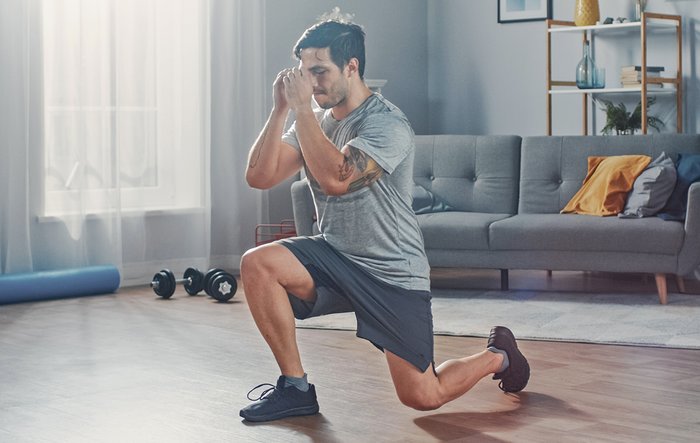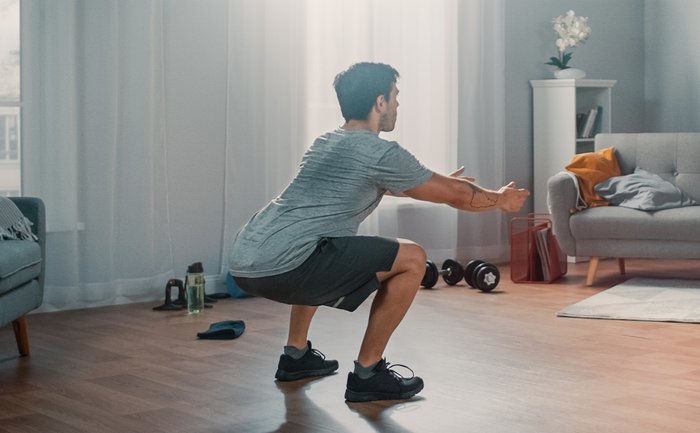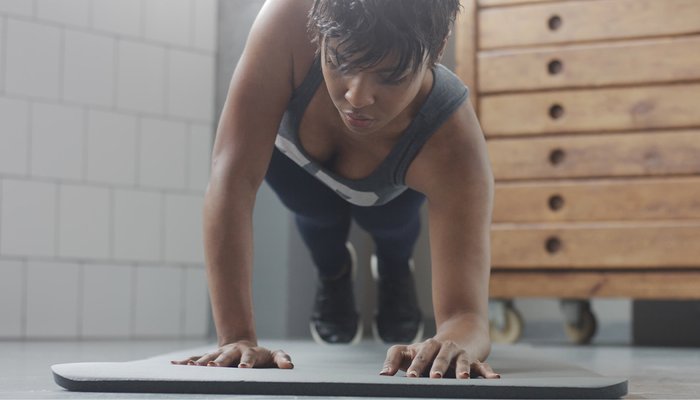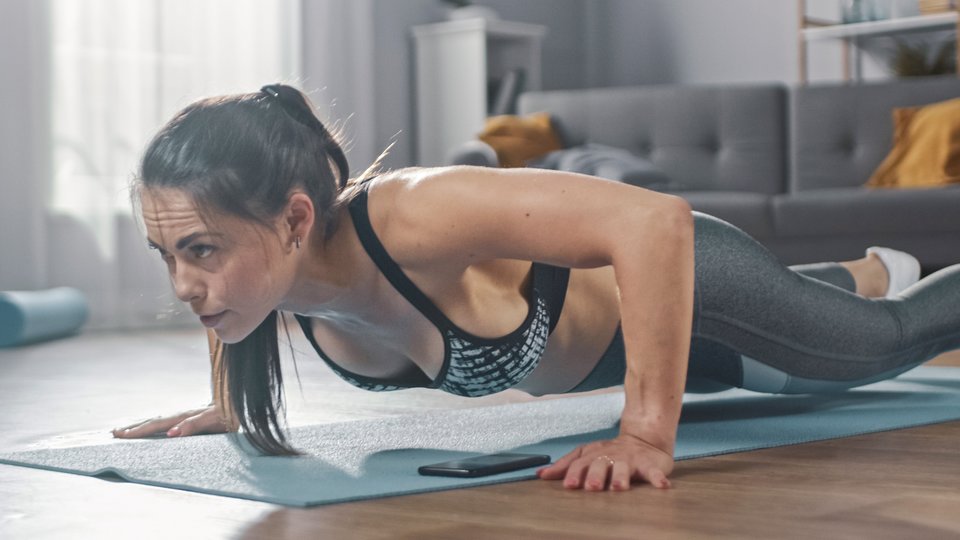During a pandemic like the one the world is currently experiencing, countless people are stuck at home with minimal exercise equipment. That doesn’t mean you can’t have great workouts and improve your physique. Here are 20 effective strategies for increasing your workout intensity without adding more external resistance.
1. Do Negative-Focused Work
The negative, or eccentric, portion of an exercise is the part where the muscle stretches under control. Slowing down the negative stroke leads to increased muscle fiber damage and soreness in the window after a workout. Additionally, you are always stronger on the eccentric part than the concentric, or positive, part of an exercise, so slowing down the eccentric movement enables you to build more strength and control without letting gravity pull you down. Emphasizing the negative builds time under tension, which is important for muscle growth.
In performing an exercise, make the eccentric portion last for 3-5 seconds; for instance, on push-ups, take 5 seconds to lower your torso to the bottom of the movement, and then come up.
2. Take Shorter Rests Between Sets
Simply reduce your regular rest intervals. Instead of resting for 90 seconds, drop it to a minute.
Another option is to perform two exercises one after another with no rest between them and then rest before the next double set, instead of doing straight sets of each with a rest after each set. For instance, you might do a set of push-ups followed immediately by a set of inverted rows.
3. Do Unilateral Work
Switch from bilateral (both limbs at once) exercises to unilateral (one limb at a time) ones. This enables you to bring up physique weaknesses and imbalances and improve muscle symmetry. For example, instead of performing squats, do Bulgarian split squats; instead of deadlifts, do single-leg deadlifts; instead of rows, perform single-arm rows.
4. Create Longer Levers
Place the resistance farther away from the working muscle. The farther the resistance is, the harder the exercise becomes. For instance, during a glute bridge, instead of placing the dumbbell right at the top of your thighs, position it away from your hips or at the end of the thighs; during a lateral walk, instead of placing the band above your knees, put it below your knees at your ankles; during a plank, instead of placing your elbows under your shoulders, plant them outside the shoulders.
5. Increase Your Range of Motion
When you increase your range of motion beyond what you can control, you stimulate more muscle fibers. For example, instead of glute bridges, try doing hip thrusts; instead of split squats, do front-foot-elevated split squats.

6. Increase Your Reps
Doing more repetitions with the same amount of weight is a prime example of progressive overload. So, if you’re used to working in the 6-10-rep range, up your reps to 10-15 while sticking with the same weight. Adapting to the new rep range should lead to new muscle growth.
7. Become Unstable
I’m referring to your workouts, of course. The more points of contact your body has with the ground, the more stable you tend to be. So, if you reduce points of contact or narrow the base of support, you will have less stability, which will increase exercise intensity. One great example is the bird dog single-arm row.
8. Use High-Intensity Techniques
Bodybuilding staples such as pre-exhaust, forced reps, dropsets, and rest-pauses got their reputations for a reason. They are proven techniques that will increase blood flow into the muscle and enable you to do more work in a given time.
If you’re interested in pre-exhaust, check out Living Large with Jay Cutler, who’s a big fan of the technique. Project Mass makes great use of forced reps, and dropsets are integral to Maximum Muscle. As for rest-pause, Shortcut to Size exploits that technique to the max.
9. Do Pulses and Pauses
Adding pulses or pauses during an exercise increases the time under tension and forces your body to work harder in a disadvantageous position. For instance, do a pause or a double pulse at the bottom of a squat or add a pause at the bottom of a push-up.

10. Change Your Grip
Try different grips to change the exercise slightly and stimulate different fibers; for example, an underhand grip, overhand grip, mixed grip, neutral grip, or over-to-under grip. This tiny difference in execution can make an exercise more difficult.
11. Perform 1-1/2 Reps
In performing 1-1/2 reps, you add a partial range of motion to a full range of motion to complete a single rep. For instance, on dumbbell sumo deadlifts, bring the dumbbell all the way down, extend your hips and bring the dumbbell up to above your knees, come all the way down again, then fully extend at your hips as you come back up to the starting position.
12. Improve Your Exercise Efficiency
Now is the time to work on improving your exercise technique. Better technique means more stimulation of the muscles you are trying to grow.
13. Train More Frequently
More workouts mean more opportunities to stimulate muscle growth. Research has shown that training a muscle group 2-3 days per week is superior to training it once per week.

14. Don’t Perform Alternating Reps
During unilateral training, don’t alternate reps from side to side in a set. Instead, perform all the reps on one side and then all the reps on the other side. Alternating reps on the left and right sides gives your muscles a chance to rest after each rep, which is the opposite of what you want if you’re trying to make the workout harder. In order to increase the intensity of the workout, you want to get close to failure on each set.
15. Change the Order of Exercises
Performing your exercises in a different order provides another new stimulus for growth.
Say you’re used to performing your exercises for push day in this order: chest press, unilateral overhead press, push-up, lateral raise, rear-delt fly, overhead triceps extension. You can make the same workout feel completely different by changing the order to this: unilateral overhead press, lateral raise, rear-delt fly, chest press, overhead triceps extension, push-up. The difference is that you have the most energy for the exercises that come first in the workout.
16. Change Your Workout Split
Your body-part split—or lack thereof—is another training factor you can change to trigger new growth. If you’re used to doing an upper-lower split, try a full-body workout. If you’re used to doing full-body workouts three times a week, switch to two upper-body and two lower-body workouts per week.
17. Add Bands or Sliders
Resistance bands and sliders are great gadgets for increasing exercise intensity without adding resistance. You can loop a band above your knees during squats or hip thrusts or perform sliding Romanian deadlifts instead of your regular RDLs. You’ll be surprised by how challenging these exercises can be once you add another layer of difficulty.
18. Change Your Positioning
Changing your stance or body positioning on an exercise changes it in the same way that changing your grip does—it brings new stimulus. Instead of doing seated overhead shoulder presses, try standing shoulder presses. Instead of staggered-stance deadlifts, try single-leg deadlifts, and so on. Even a small difference in body positioning or stance can make a significant difference in the amount you can lift.
19. Use Offset Loads
Offset loads challenge your core strength and stability as well as lumbopelvic stability. They’re also a great way to improve imbalances between sides of the body. An offset load is one that is heavier on one side of the body than the other on a bilateral movement—on suitcase deadlifts and offset squats, for instance. If your body isn’t used to this type of training, it will be challenging for you.
20. Try Different Exercise Variations
There are hundreds of variations for each exercise. If you modify your exercises according to the strategies discussed above, there’s no end to the new growth stimulus you can introduce to your muscles.
